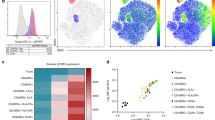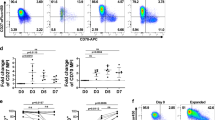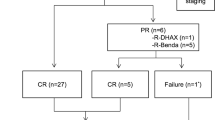Abstract
The present pilot study aims to evaluate the frequency and the function of regulatory T (Treg) cells in patients with diffuse cutaneous SSc (dcSSc) before and after autologous hematopoietic SCT (aHSCT). Peripheral blood lymphocytes from seven dcSSc patients were analyzed before and 24 months after aHSCT and were compared with those from seven healthy donors (controls). Immunophenotyping of CD4+CD25highFoxP3+ natural Treg (nTreg), CD4+CD25+TGF-β+ and CD4+CD25+IL-10+ adaptive Treg (aTreg) cell subsets was performed using four-color flow cytometry. Treg-suppressive capability was measured after coculture with autologous T effector cells by evaluation of T-cell proliferation using 3H-thymidine incorporation. Peripheral CD4+CD25highFoxP3+ (2±0.5 vs 4.2±1.1, P<0.01), CD4+CD25+TGF-β+ (6.9±1.8 vs 14.6±5.0, P<0.05) and CD4+CD25+IL-10+ (10.7±0.5 vs 16.1±3.2, P<0.01) Tregs as well as CD4+CD25highCD127low Tregs suppressive capacity (P<0.05) were decreased in dcSSc patients vs controls. After aHSCT (n=7), the percentages of CD4+CD25highFoxP3+ (4.1±1.8) and CD4+CD25+IL-10+ (15.7±2.2) Treg cells and the suppressive activity of CD4+CD25highCD127low were restored to the levels in controls. The decreased frequency and the functional defect of peripheral Treg cells from patients with dcSSc are reversed following aHSCT to reach those observed in controls. This pilot study brings evidence of an effective restoration of nTreg and aTreg subsets, and recovery of nTreg suppressive function following aHSCT.
This is a preview of subscription content, access via your institution
Access options
Subscribe to this journal
Receive 12 print issues and online access
$259.00 per year
only $21.58 per issue
Buy this article
- Purchase on Springer Link
- Instant access to full article PDF
Prices may be subject to local taxes which are calculated during checkout



Similar content being viewed by others
References
Gabrielli A, Avvedimento EV, Krieg T . Scleroderma. N Engl J Med 2009; 360: 1989–2003.
Baraut J, Michel L, Verrecchia F, Farge D . Relationship between cytokine profiles and clinical outcomes in patients with systemic sclerosis. Autoimmun Rev 2010; 10: 65–73.
Chizzolini C . T cells, B cells, and polarized immune response in the pathogenesis of fibrosis and systemic sclerosis. Curr Opin Rheumatol 2008; 20: 707–712.
Yurovsky VV, Wigley FM, Wise RA, White B . Skewing of the CD8+ T-cell repertoire in the lungs of patients with systemic sclerosis. Hum Immunol 1996; 48: 84–97.
Dieckmann D, Plottner H, Berchtold S, Berger T, Schuler G . Ex vivo isolation and characterization of CD4(+)CD25(+) T cells with regulatory properties from human blood. J Exp Med 2001; 193: 1303–1310.
Fontenot JD, Gavin MA, Rudensky AY . Foxp3 programs the development and function of CD4+CD25+ regulatory T cells. Nat Immunol 2003; 4: 330–336.
Bluestone JA, Abbas AK . Natural versus adaptive regulatory T cells. Nat Rev Immunol 2003; 3: 253–257.
Sakaguchi S, Sakaguchi N, Shimizu J, Yamazaki S, Sakihama T, Itoh M et al. Immunologic tolerance maintained by CD25+ CD4+ regulatory T cells: their common role in controlling autoimmunity, tumor immunity, and transplantation tolerance. Immunol Rev 2001; 182: 18–32.
Takahashi T, Tagami T, Yamazaki S, Uede T, Shimizu J, Sakaguchi N et al. Immunologic self-tolerance maintained by CD25(+)CD4(+) regulatory T cells constitutively expressing cytotoxic T lymphocyte-associated antigen 4. J Exp Med 2000; 192: 303–310.
Wood KJ, Sakaguchi S . Regulatory T cells in transplantation tolerance. Nat Rev Immunol 2003; 3: 199–210.
Curotto de Lafaille MA, Lafaille JJ . CD4(+) regulatory T cells in autoimmunity and allergy. Curr Opin Immunol 2002; 14: 771–778.
Banica L, Besliu A, Pistol G, Stavaru C, Ionescu R, Forsea A-M et al. Quantification and molecular characterization of regulatory T cells in connective tissue diseases. Autoimmunity 2009; 42: 41–49.
Brusko TM, Putnam AL, Bluestone JA . Human regulatory T cells: role in autoimmune disease and therapeutic opportunities. Immunol Rev 2008; 223: 371–390.
Bonelli M, Savitskaya A, von Dalwigk K, Steiner CW, Aletaha D, Smolen JS et al. Quantitative and qualitative deficiencies of regulatory T cells in patients with systemic lupus erythematosus (SLE). Int Immunol 2008; 20: 861–868.
Cao D, Malmström V, Baecher-Allan C, Hafler D, Klareskog L, Trollmo C . Isolation and functional characterization of regulatory CD25brightCD4+ T cells from the target organ of patients with rheumatoid arthritis. Eur J Immunol 2003; 33: 215–223.
Viglietta V, Baecher-Allan C, Weiner HL, Hafler DA . Loss of functional suppression by CD4+CD25+ regulatory T cells in patients with multiple sclerosis. J Exp Med 2004; 199: 971–979.
Kriegel MA, Lohmann T, Gabler C, Blank N, Kalden JR, Lorenz H-M . Defective suppressor function of human CD4+ CD25+ regulatory T cells in autoimmune polyglandular syndrome type II. J Exp Med 2004; 199: 1285–1291.
Balandina A, Lécart S, Dartevelle P, Saoudi A, Berrih-Aknin S . Functional defect of regulatory CD4(+)CD25+ T cells in the thymus of patients with autoimmune myasthenia gravis. Blood 2005; 105: 735–741.
Lindley S, Dayan CM, Bishop A, Roep BO, Peakman M, Tree TIM . Defective suppressor function in CD4(+)CD25(+) T-cells from patients with type 1 diabetes. Diabetes 2005; 54: 92–99.
Antiga E, Quaglino P, Bellandi S, Volpi W, Del Bianco E, Comessatti A et al. Regulatory T cells in the skin lesions and blood of patients with systemic sclerosis and morphoea. Br J Dermatol 2010; 162: 1056–1063.
Papp G, Horvath IF, Barath S, Gyimesi E, Sipka S, Szodoray P et al. Altered T-cell and regulatory cell repertoire in patients with diffuse cutaneous systemic sclerosis. Scand J Rheumatol 2011; 40: 205–210.
Fenoglio D, Battaglia F, Parodi A, Stringara S, Negrini S, Panico N et al. Alteration of Th17 and Treg cell subpopulations co-exist in patients affected with systemic sclerosis. Clin Immunol 2011; 139: 249–257.
Radstake TRDJ, van Bon L, Broen J, Wenink M, Santegoets K, Deng Y et al. Increased frequency and compromised function of T regulatory cells in systemic sclerosis (SSc) is related to a diminished CD69 and TGFbeta expression. PLoS One 2009; 4: e5981.
Giovannetti A, Rosato E, Renzi C, Maselli A, Gambardella L, Giammarioli AM et al. Analyses of T cell phenotype and function reveal an altered T cell homeostasis in systemic sclerosis. Correlations with disease severity and phenotypes. Clin Immunol 2010; 137: 122–133.
Slobodin G, Ahmad MS, Rosner I, Peri R, Rozenbaum M, Kessel A et al. Regulatory T cells (CD4(+)CD25(bright)FoxP3(+)) expansion in systemic sclerosis correlates with disease activity and severity. Cell Immunol 2010; 261: 77–80.
Klein S, Kretz CC, Ruland V, Stumpf C, Haust M, Hartschuh W et al. Reduction of regulatory T cells in skin lesions but not in peripheral blood of patients with systemic scleroderma. Ann Rheum Dis 2011; 70: 1475–1481.
Burt RK, Shah SJ, Dill K, Grant T, Gheorghiade M, Schroeder J et al. Autologous non-myeloablative haemopoietic stem-cell transplantation compared with pulse cyclophosphamide once per month for systemic sclerosis (ASSIST): an open-label, randomised phase 2 trial. Lancet 2011; 378: 498–506.
Vonk MC, Marjanovic Z, van den Hoogen FHJ, Zohar S, Schattenberg AVMB, Fibbe WE et al. Long-term follow-up results after autologous haematopoietic stem cell transplantation for severe systemic sclerosis. Ann Rheum Dis 2008; 67: 98–104.
Farge D, Henegar C, Carmagnat M, Daneshpouy M, Marjanovic Z, Rabian C et al. Analysis of immune reconstitution after autologous bone marrow transplantation in systemic sclerosis. Arthritis Rheum 2005; 52: 1555–1563.
Bohgaki T, Atsumi T, Bohgaki M, Furusaki A, Kondo M, Sato-Matsumura KC et al. Immunological reconstitution after autologous hematopoietic stem cell transplantation in patients with systemic sclerosis: relationship between clinical benefits and intensity of immunosuppression. J Rheumatol 2009; 36: 1240–1248.
LeRoy EC, Medsger Jr TA . Criteria for the classification of early systemic sclerosis. J Rheumatol 2001; 28: 1573–1576.
Kuhn A, Beissert S, Krammer PH . CD4(+)CD25 (+) regulatory T cells in human lupus erythematosus. Arch Dermatol Res 2009; 301: 71–81.
Liu W, Putnam AL, Xu-Yu Z, Szot GL, Lee MR, Zhu S et al. CD127 expression inversely correlates with FoxP3 and suppressive function of human CD4+ T reg cells. J Exp Med 2006; 203: 1701–1711.
Zhang L, Bertucci AM, Ramsey-Goldman R, Burt RK, Datta SK . Regulatory T cell (Treg) subsets return in patients with refractory lupus following stem cell transplantation, and TGF-beta-producing CD8+ Treg cells are associated with immunological remission of lupus. J Immunol 2009; 183: 6346–6358.
Muraro PA, Douek DC, Packer A, Chung K, Guenaga FJ, Cassiani-Ingoni R et al. Thymic output generates a new and diverse TCR repertoire after autologous stem cell transplantation in multiple sclerosis patients. J Exp Med 2005; 201: 805–816.
de Kleer I, Vastert B, Klein M, Teklenburg G, Arkesteijn G, Yung GP et al. Autologous stem cell transplantation for autoimmunity induces immunologic self-tolerance by reprogramming autoreactive T cells and restoring the CD4+CD25+ immune regulatory network. Blood 2006; 107: 1696–1702.
Alexander T, Thiel A, Rosen O, Massenkeil G, Sattler A, Kohler S et al. Depletion of autoreactive immunologic memory followed by autologous hematopoietic stem cell transplantation in patients with refractory SLE induces long-term remission through de novo generation of a juvenile and tolerant immune system. Blood 2009; 113: 214–223.
Radbruch A, Thiel A . Cell therapy for autoimmune diseases: does it have a future? Ann Rheum Dis 2004; 63: ii96–ii101.
Venigalla RKC, Tretter T, Krienke S, Max R, Eckstein V, Blank N et al. Reduced CD4+,CD25− T cell sensitivity to the suppressive function of CD4+,CD25high,CD127 -/low regulatory T cells in patients with active systemic lupus erythematosus. Arthritis Rheum 2008; 58: 2120–2130.
van Amelsfort JMR, van Roon JAG, Noordegraaf M, Jacobs KMG, Bijlsma JWJ, Lafeber FPJG et al. Proinflammatory mediator-induced reversal of CD4+,CD25+ regulatory T cell-mediated suppression in rheumatoid arthritis. Arthritis Rheum 2007; 56: 732–742.
O’Sullivan BJ, Thomas HE, Pai S, Santamaria P, Iwakura Y, Steptoe RJ et al. IL-1 beta breaks tolerance through expansion of CD25+ effector T cells. J Immunol 2006; 176: 7278–7287.
Farge D, Gluckman E . Autologous HSCT in systemic sclerosis: a step forward. Lancet 2011; 378: 460–462.
Acknowledgements
We acknowledge the Association des Sclérodermiques de France (ASF) and the Groupe Francophone de Recherche sur la Sclérodermie (GFRS). This work was supported by grants from the Groupe Français de Recherche sur la Sclérodermie (GFRS).
Author information
Authors and Affiliations
Corresponding author
Ethics declarations
Competing interests
The authors declare no conflict of interest.
Rights and permissions
About this article
Cite this article
Baraut, J., Grigore, E., Jean-Louis, F. et al. Peripheral blood regulatory T cells in patients with diffuse systemic sclerosis (SSc) before and after autologous hematopoietic SCT: a pilot study. Bone Marrow Transplant 49, 349–354 (2014). https://doi.org/10.1038/bmt.2013.202
Received:
Revised:
Accepted:
Published:
Issue Date:
DOI: https://doi.org/10.1038/bmt.2013.202
Keywords
This article is cited by
-
Tolerance regeneration by T regulatory cells in autologous haematopoietic stem cell transplantation for autoimmune diseases
Bone Marrow Transplantation (2020)
-
Emerging targets of disease-modifying therapy for systemic sclerosis
Nature Reviews Rheumatology (2019)
-
Treg cells in autoimmunity: from identification to Treg-based therapies
Seminars in Immunopathology (2019)
-
Long-term immune reconstitution and T cell repertoire analysis after autologous hematopoietic stem cell transplantation in systemic sclerosis patients
Journal of Hematology & Oncology (2017)
-
Haematopoietic stem cell transplantation for autoimmune diseases
Nature Reviews Rheumatology (2017)



